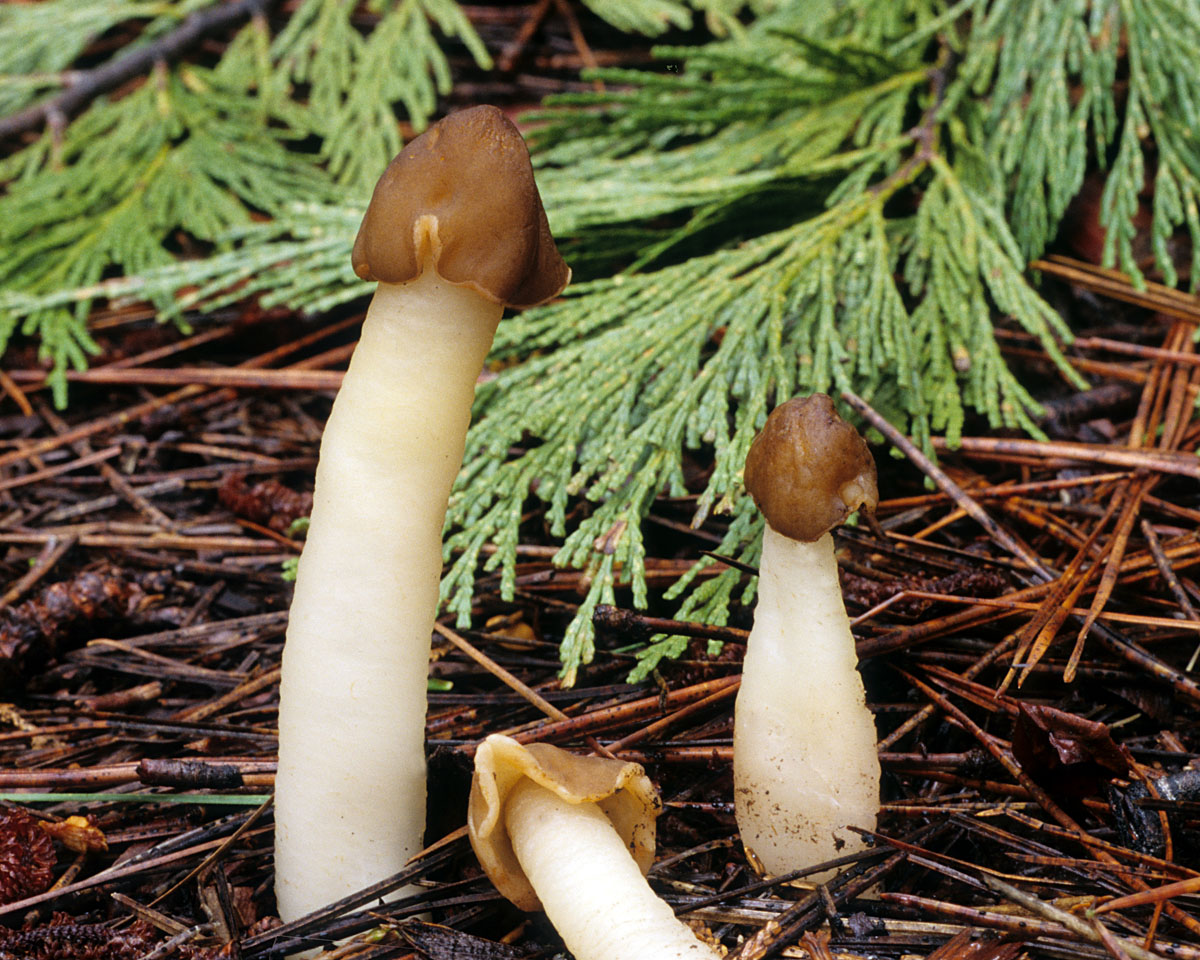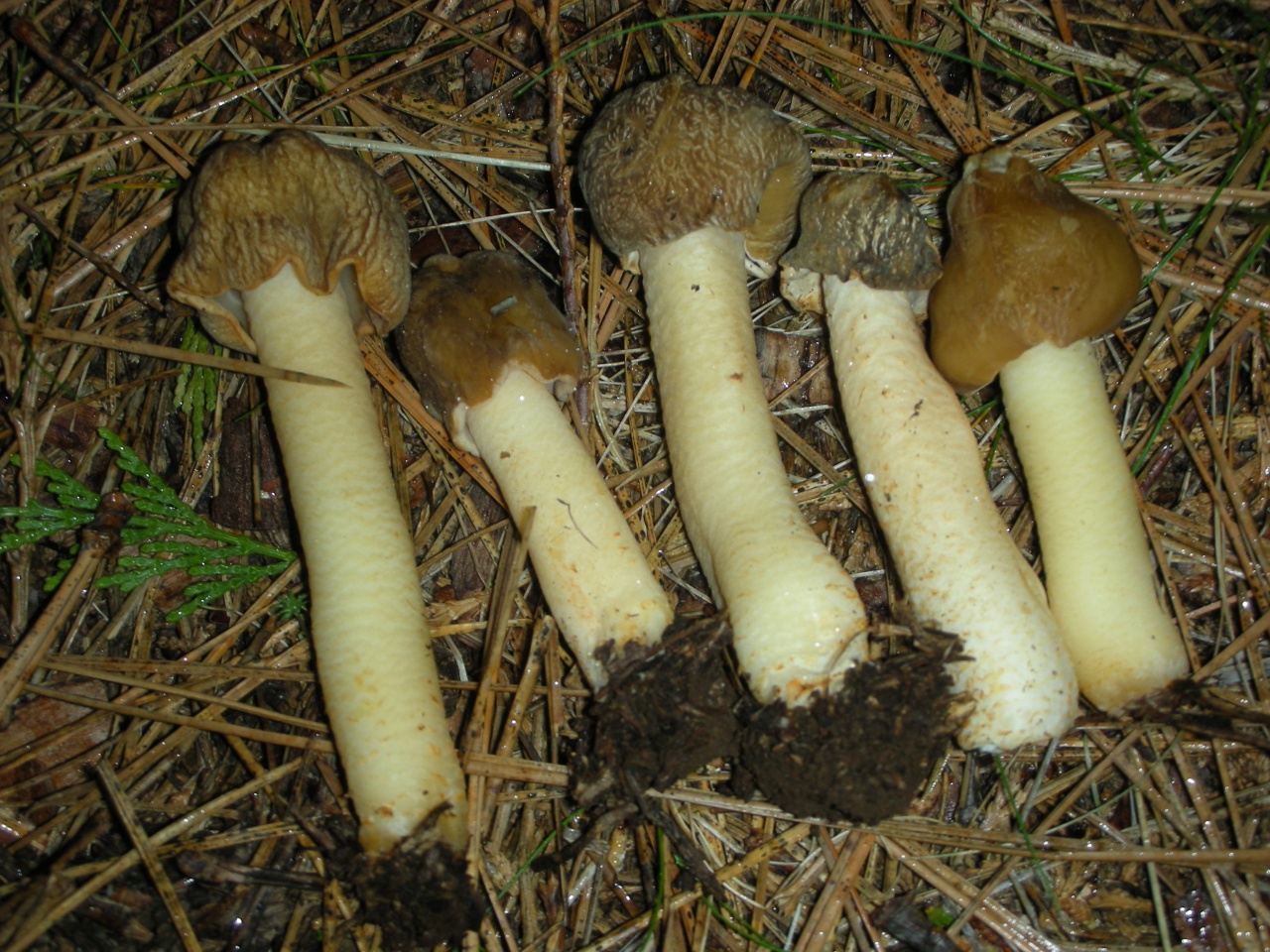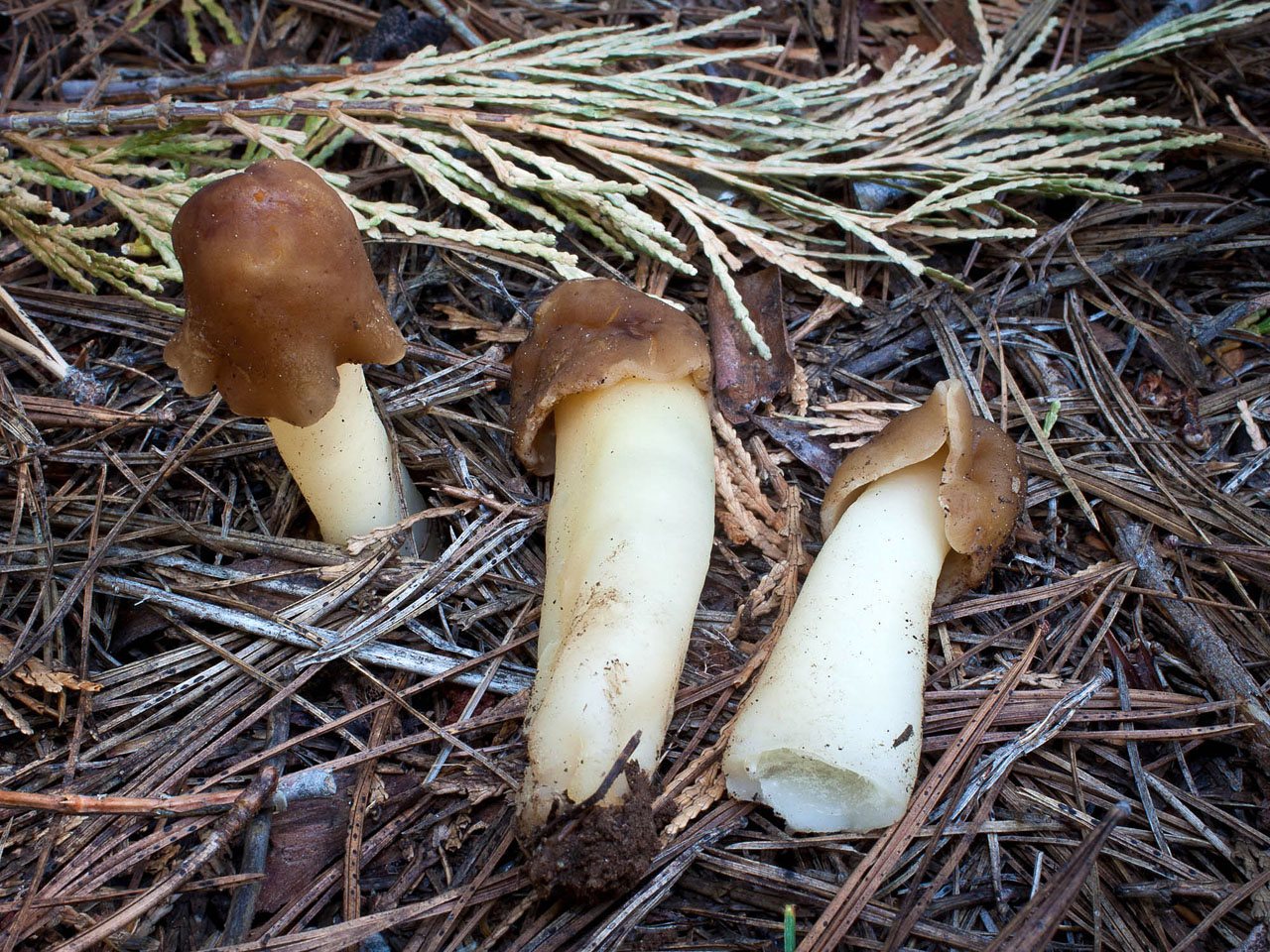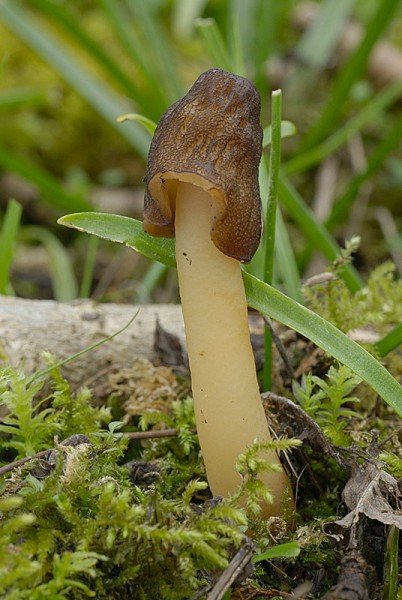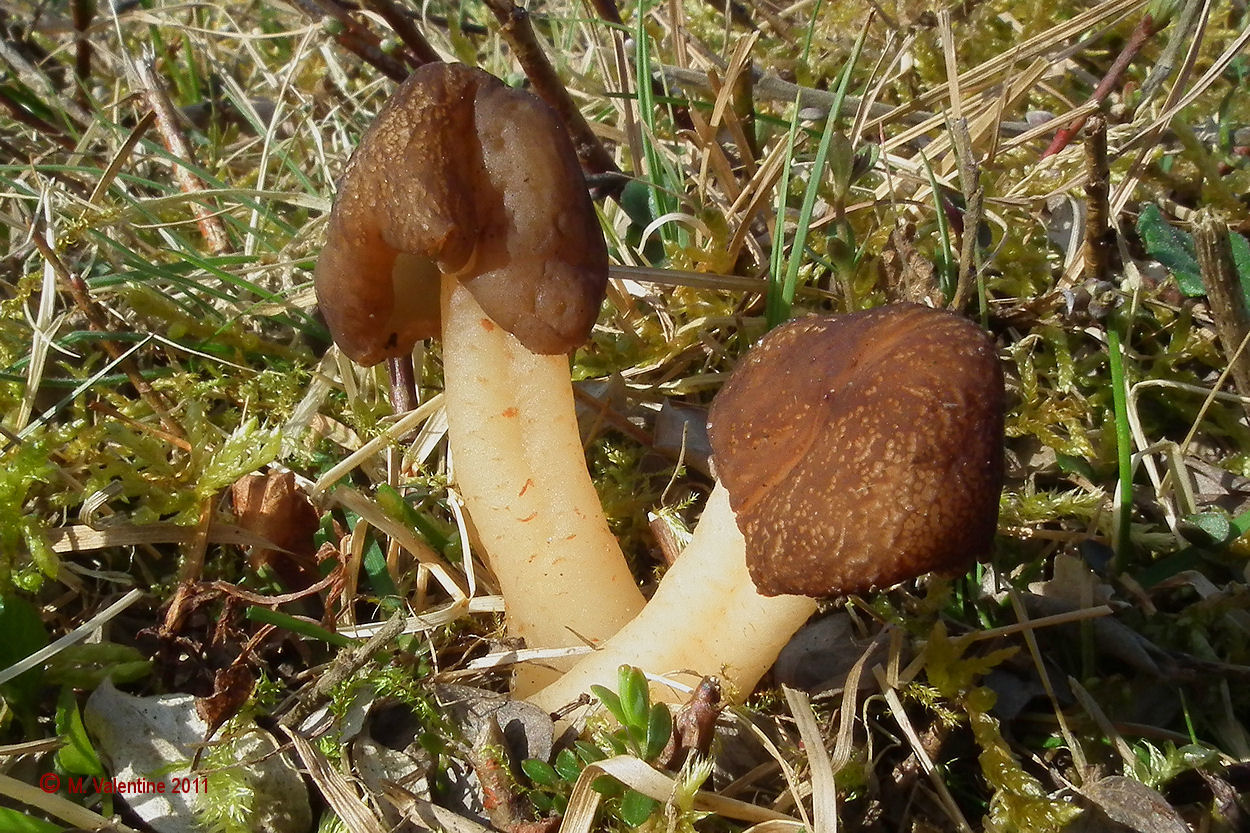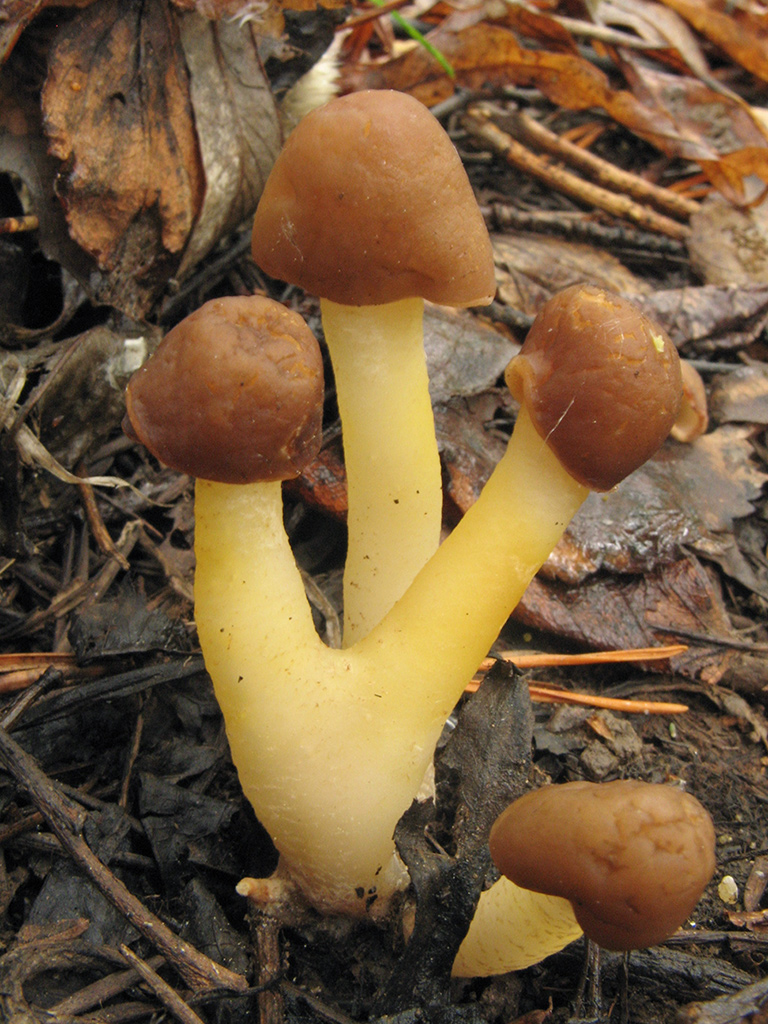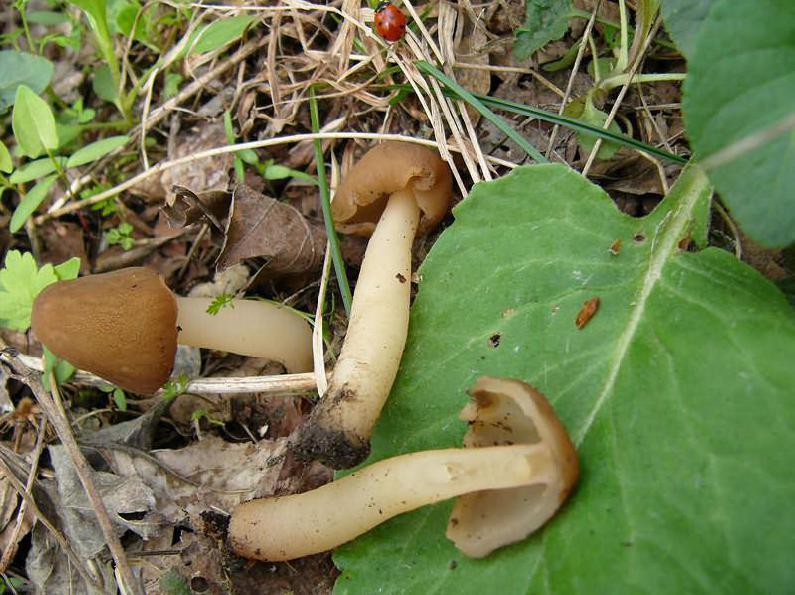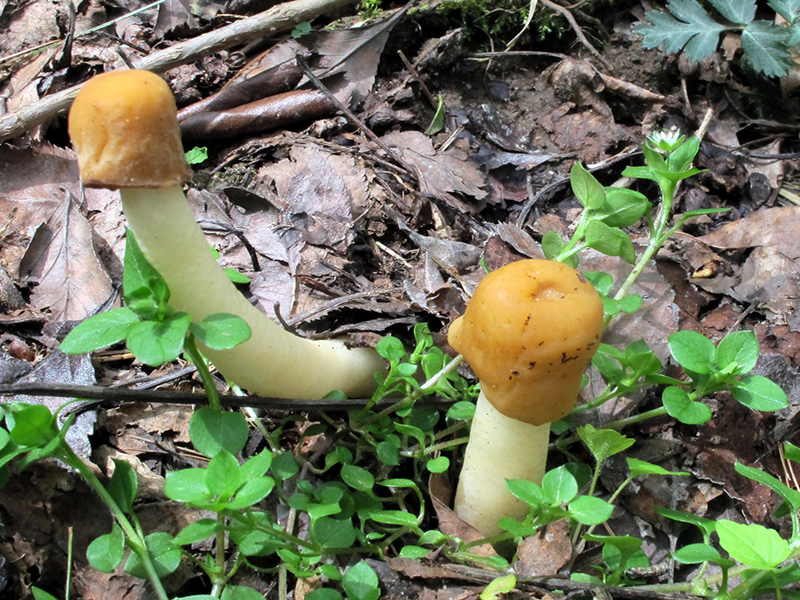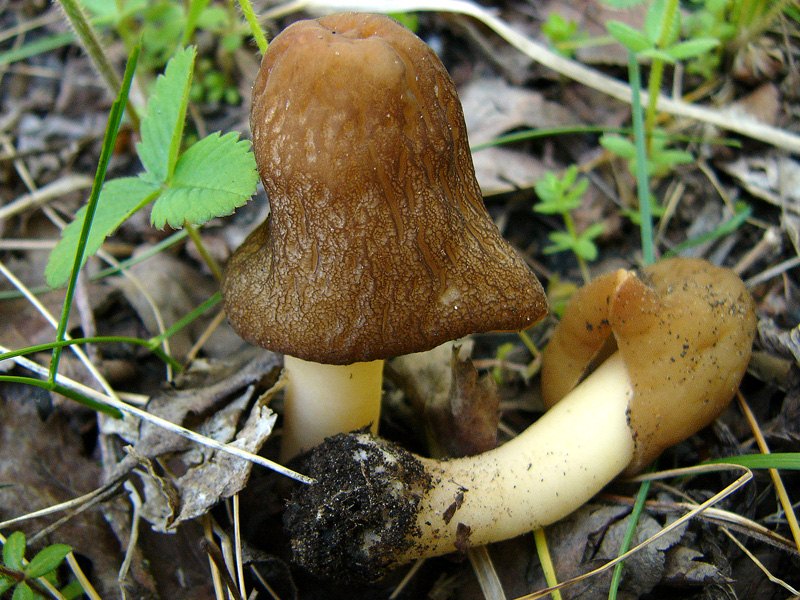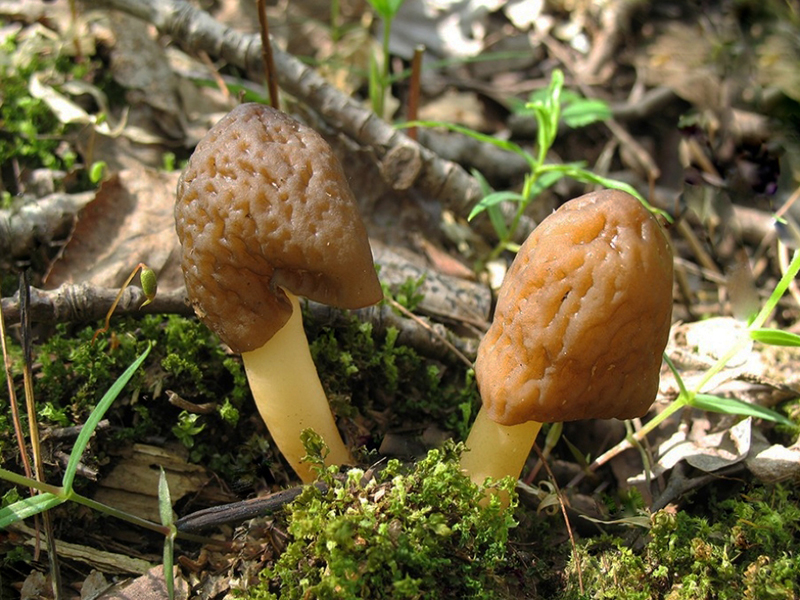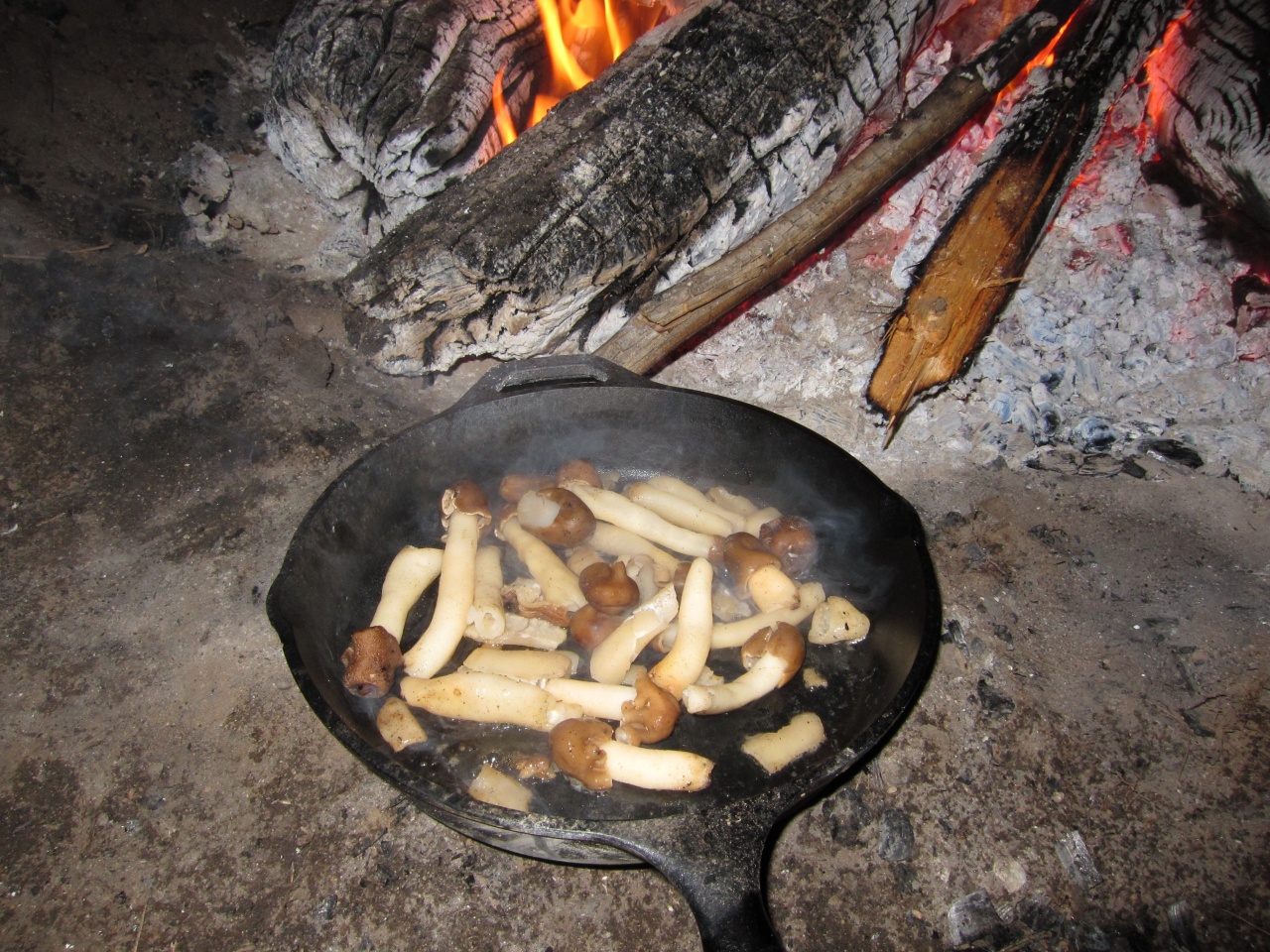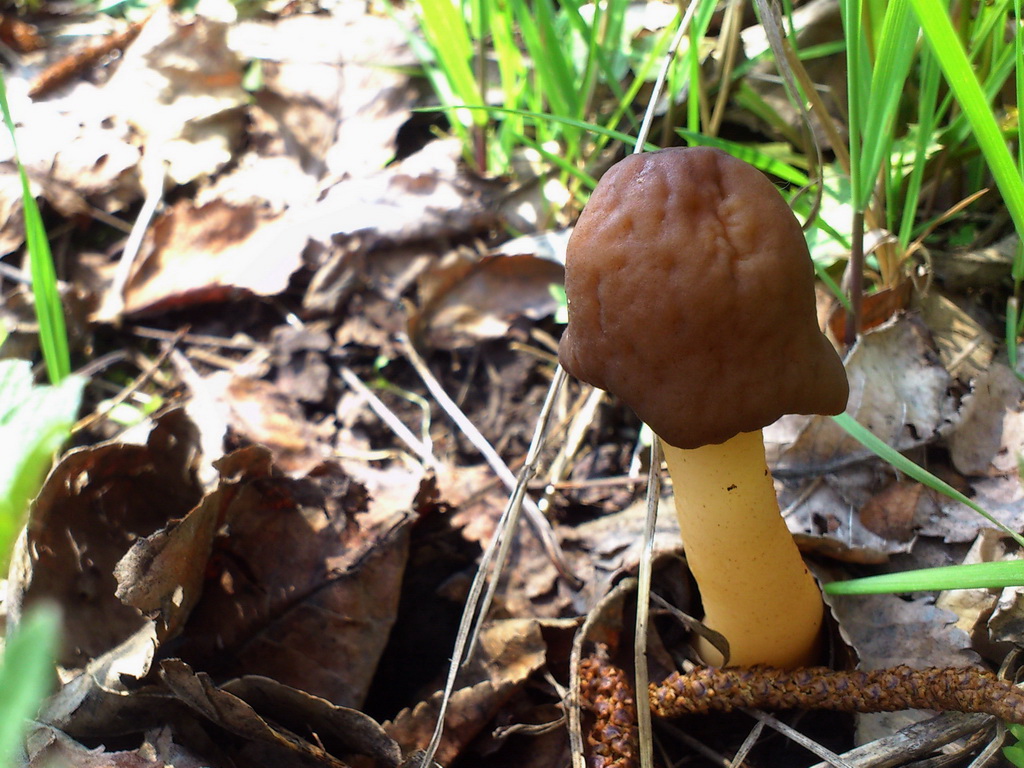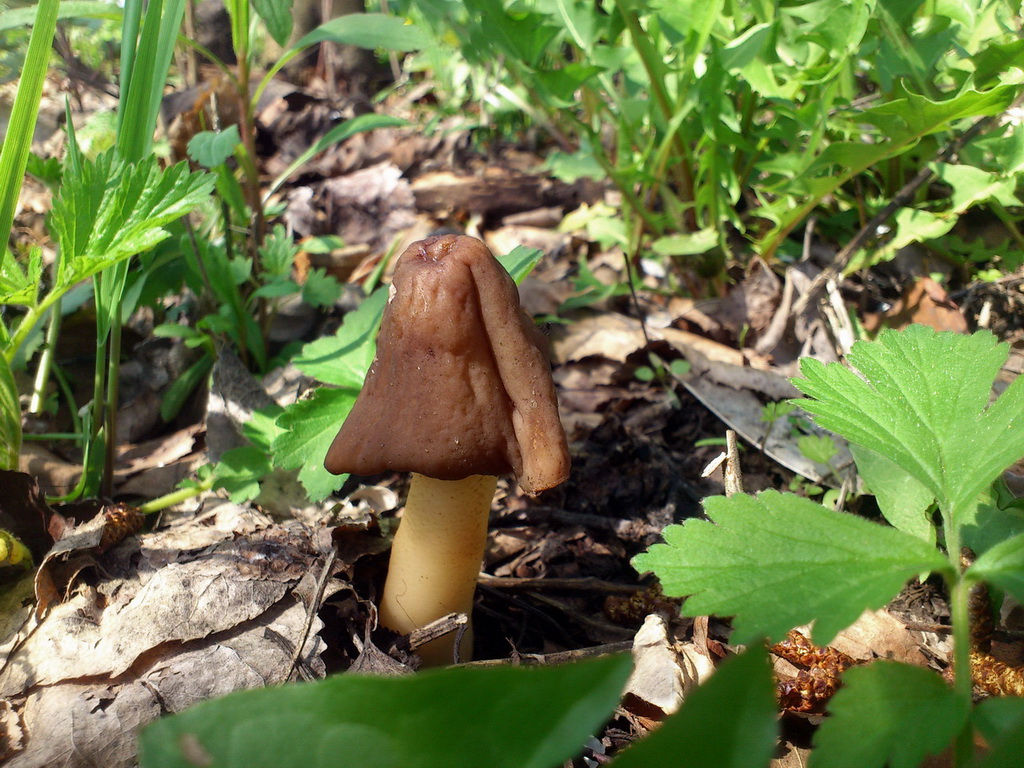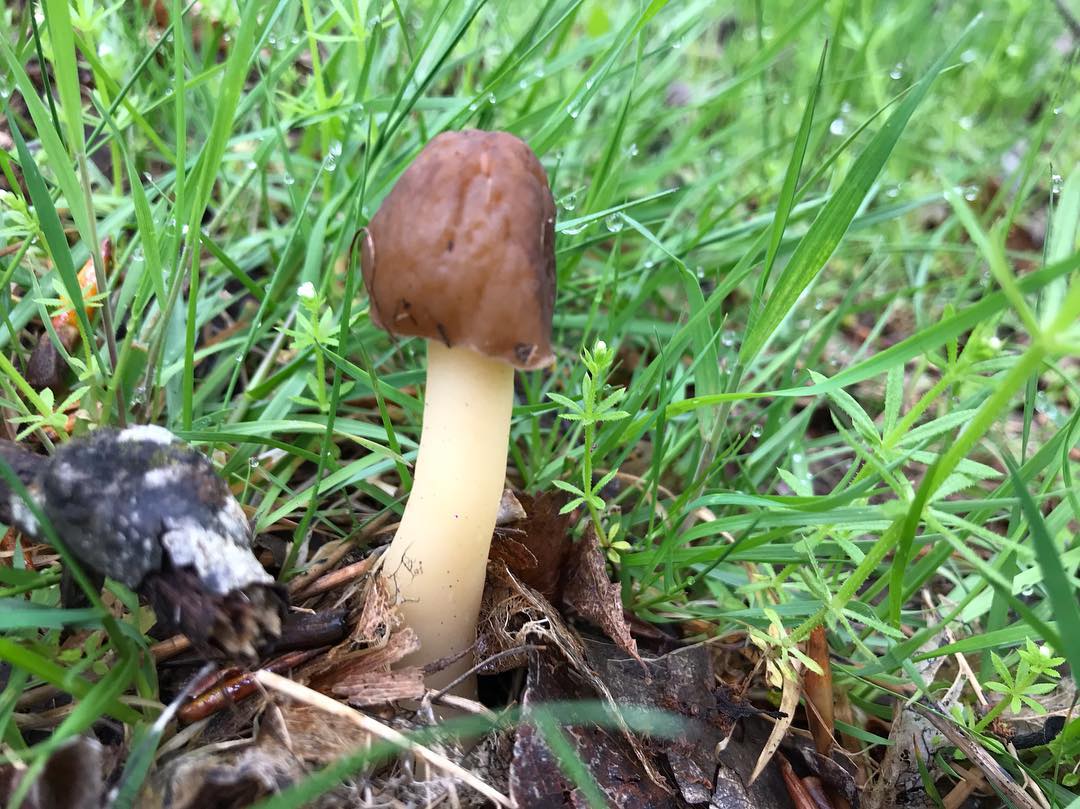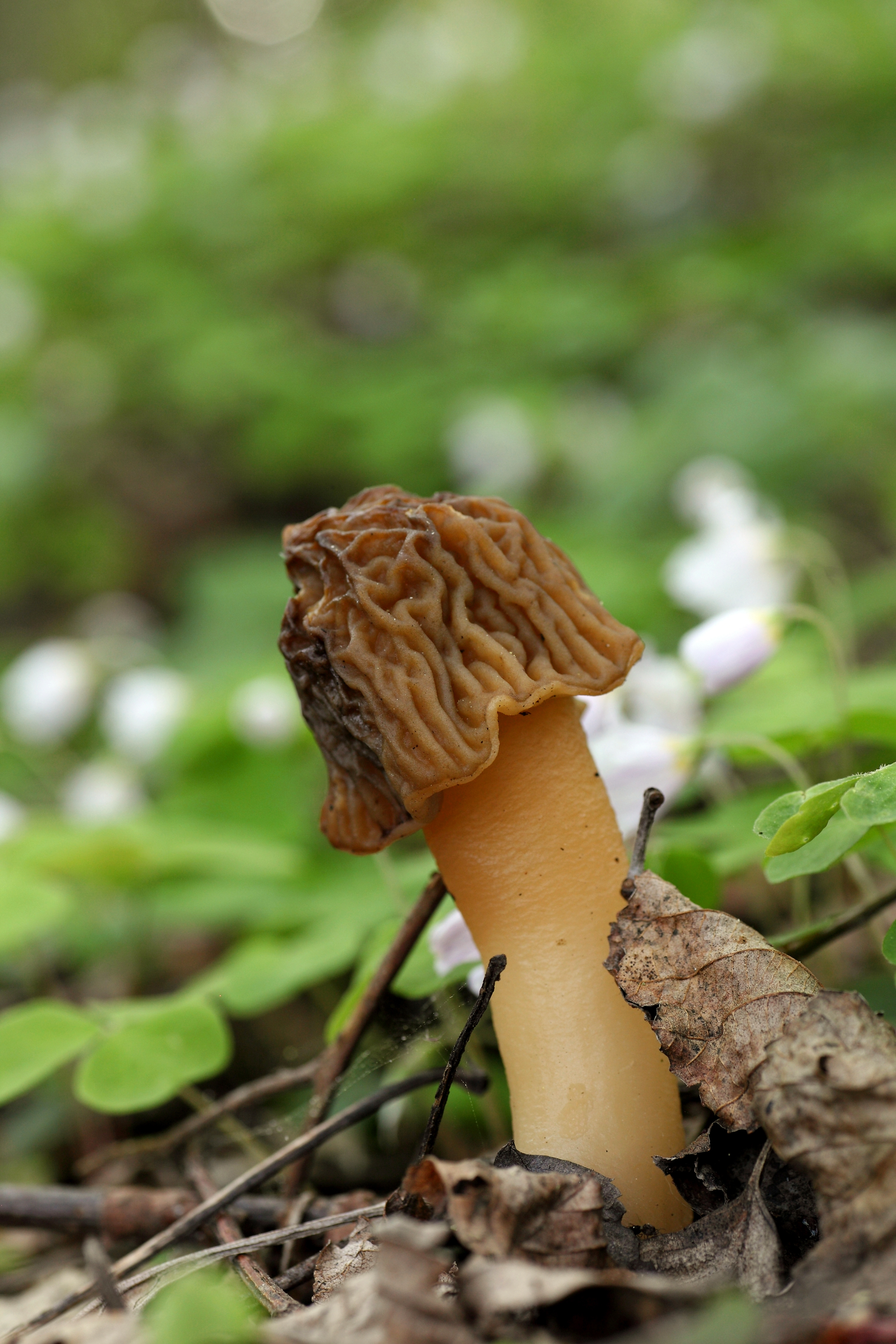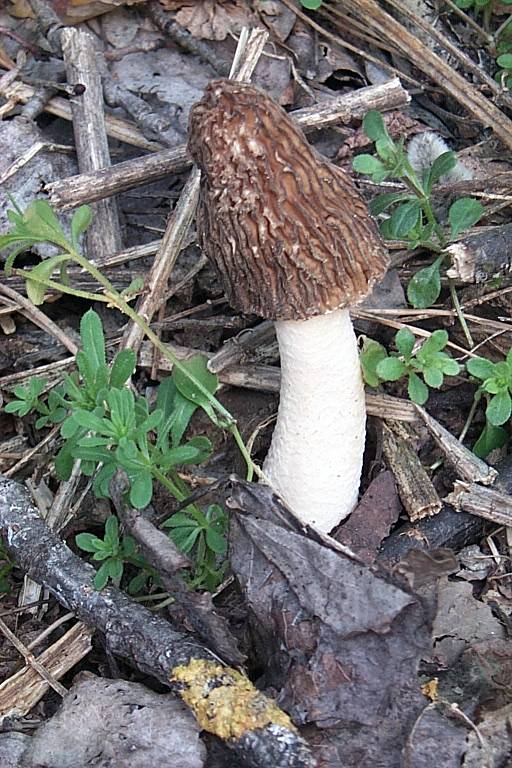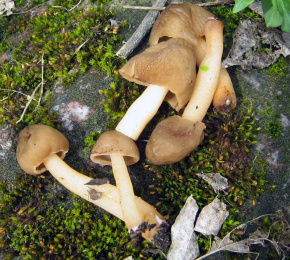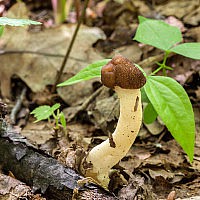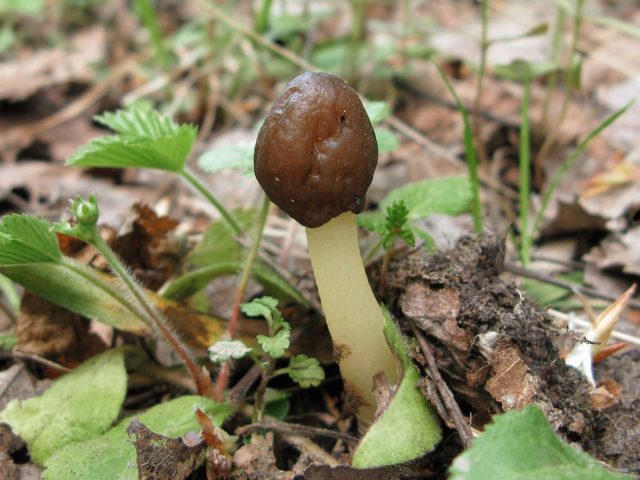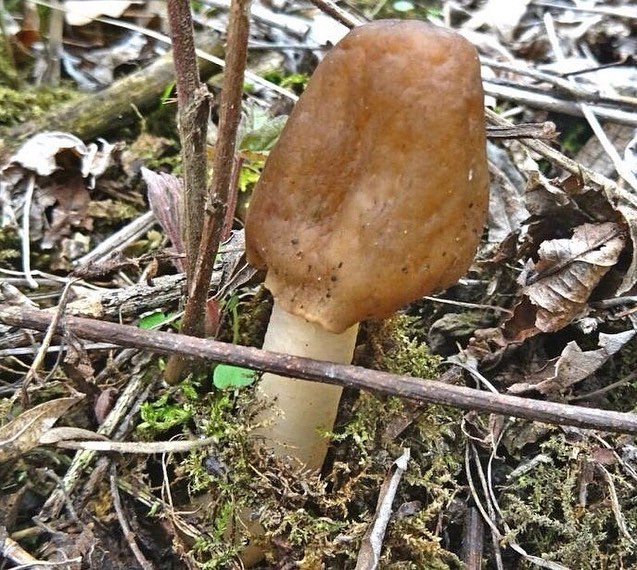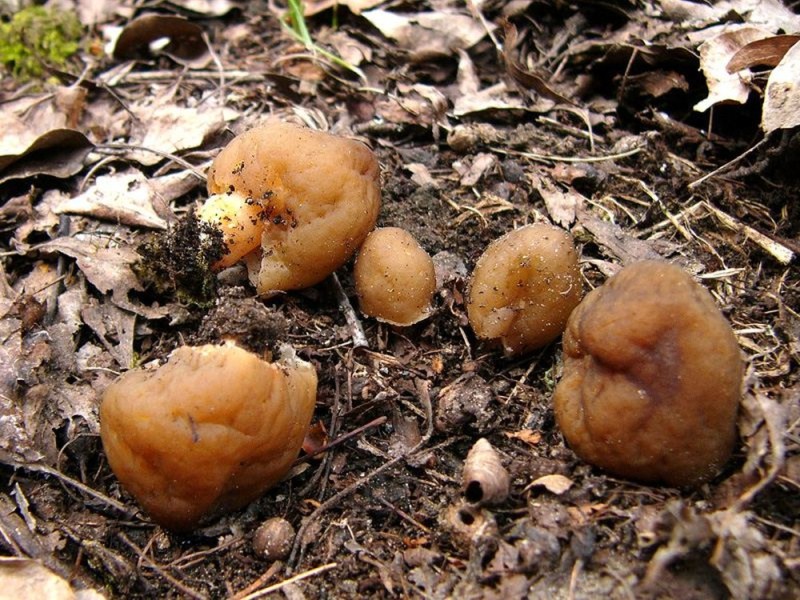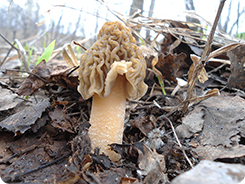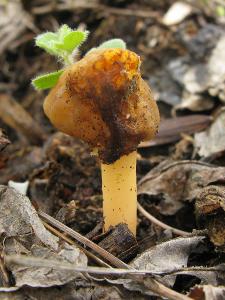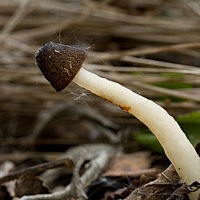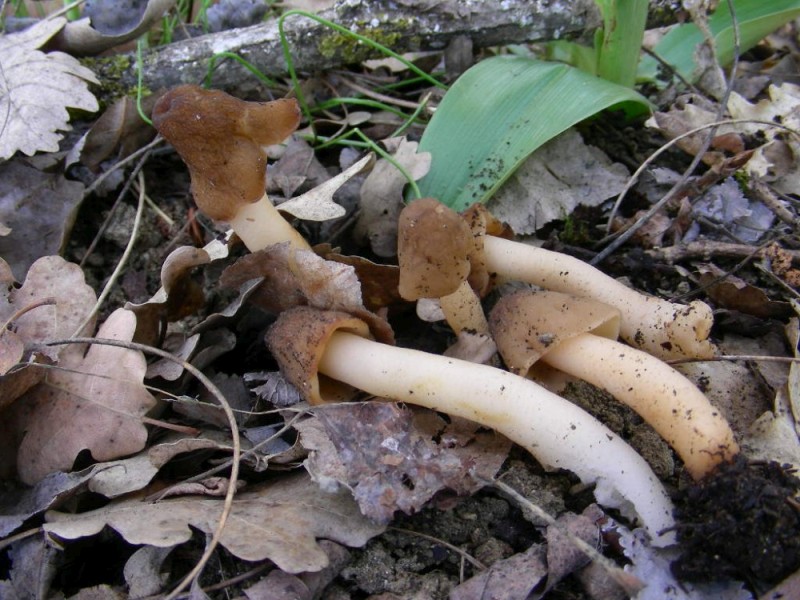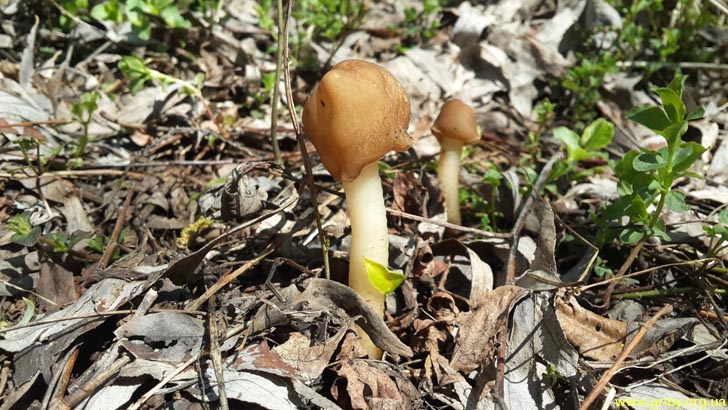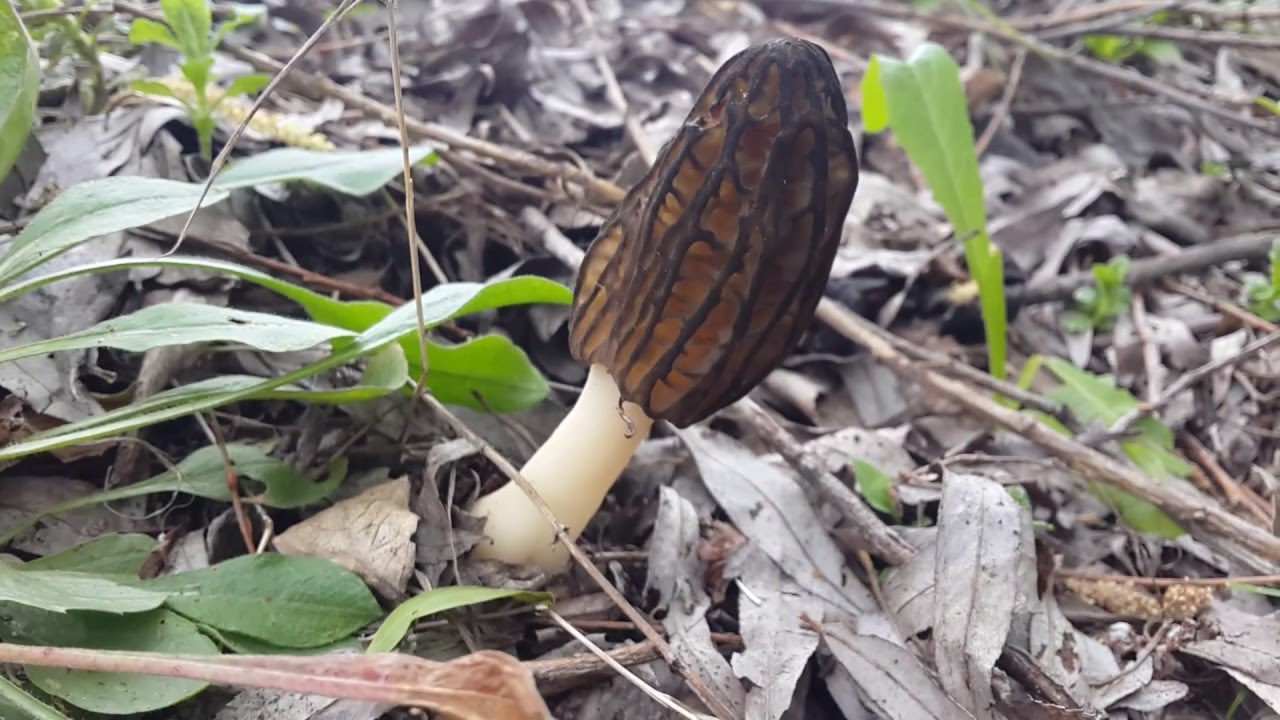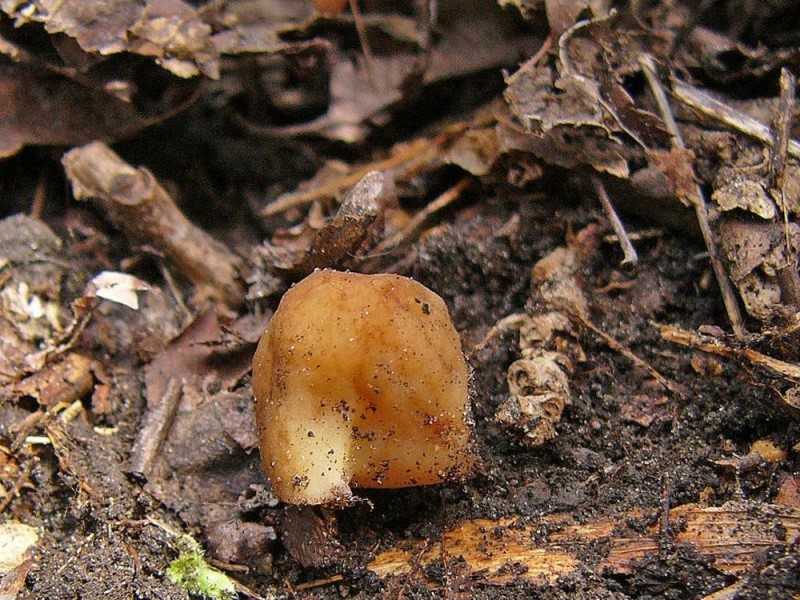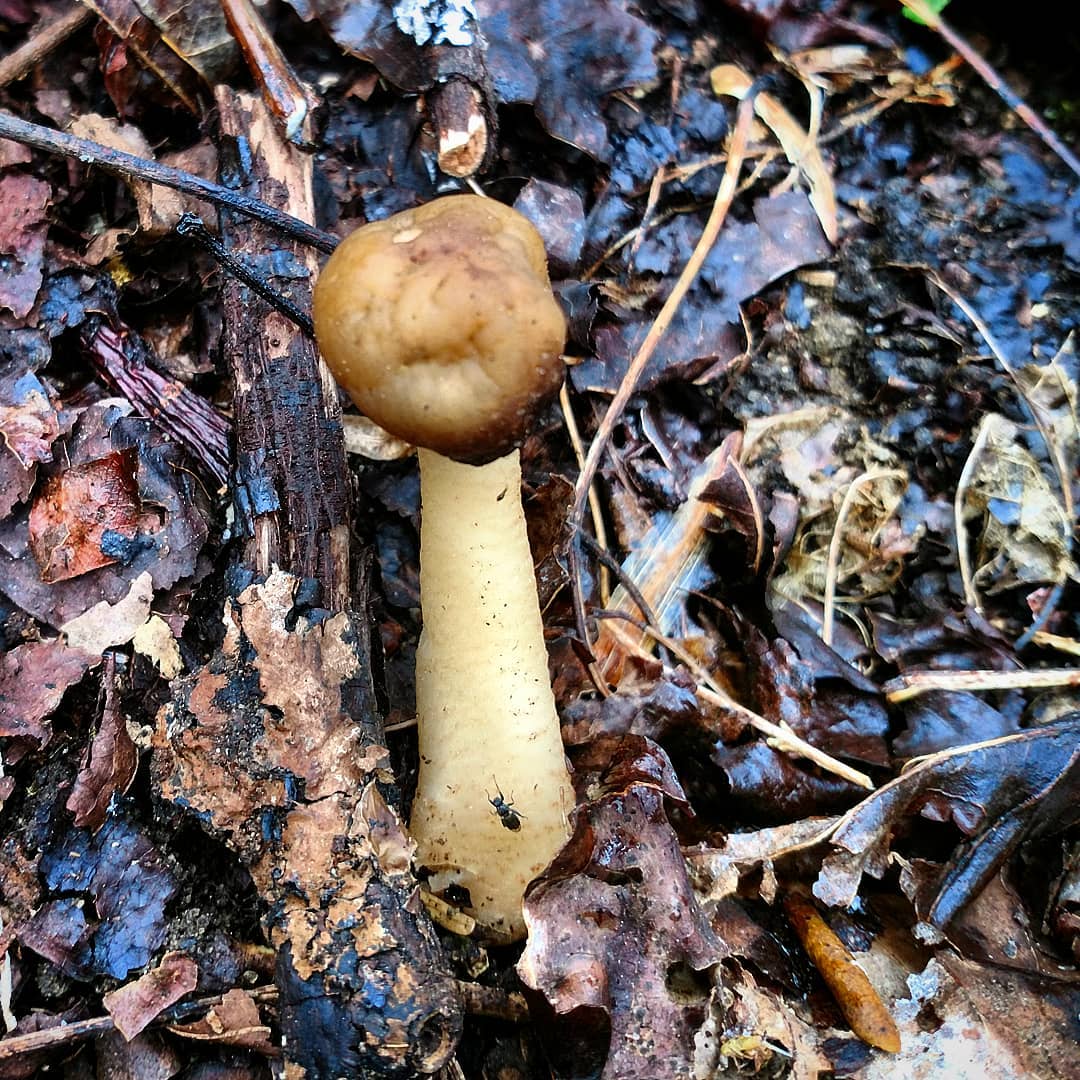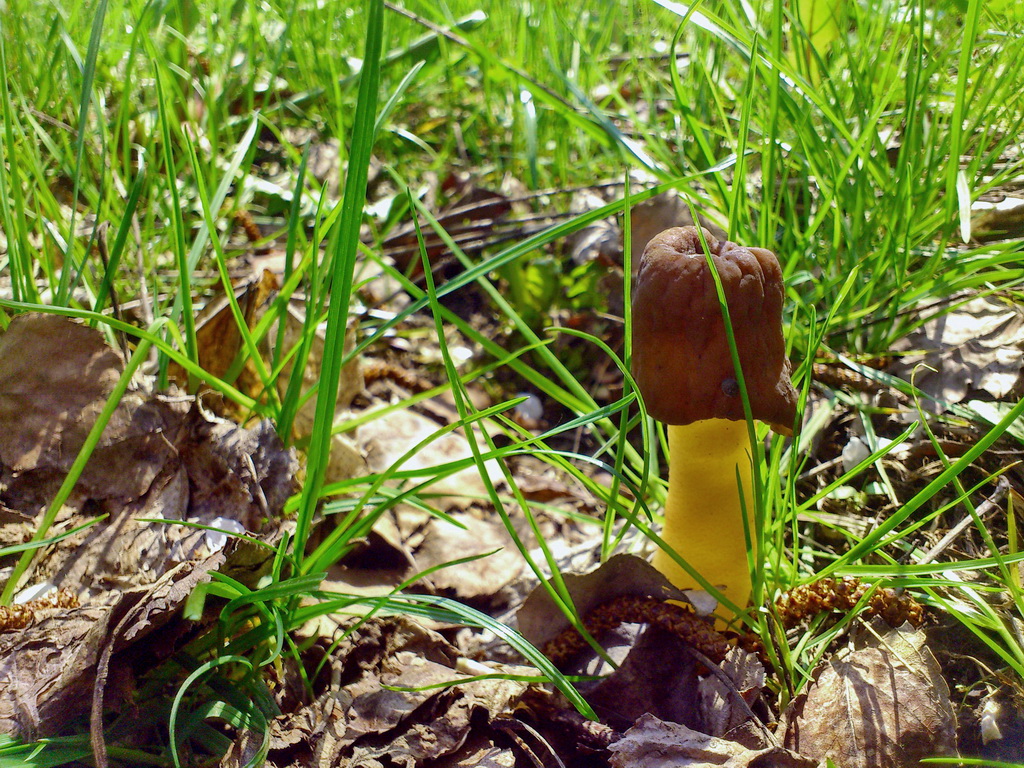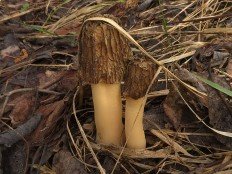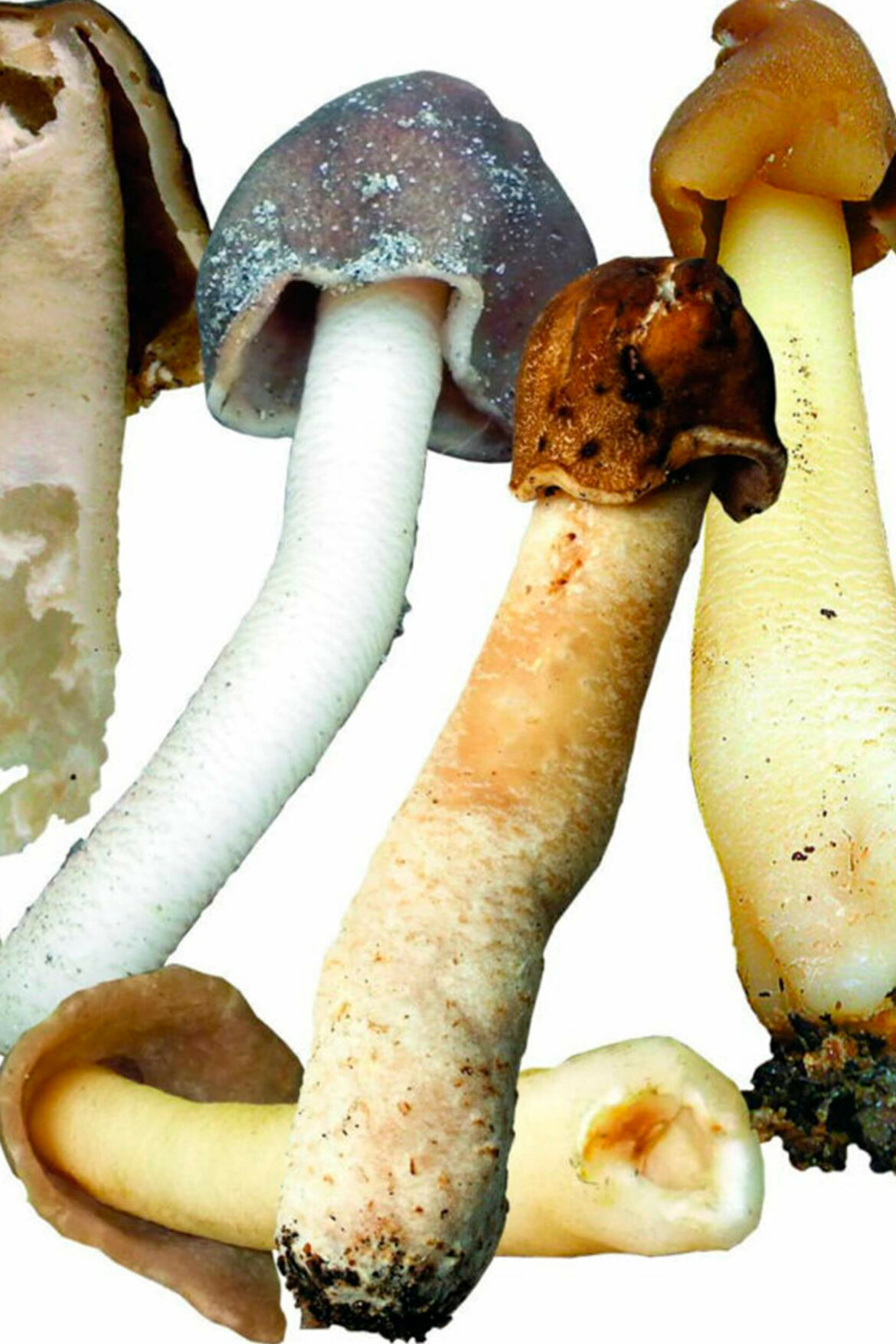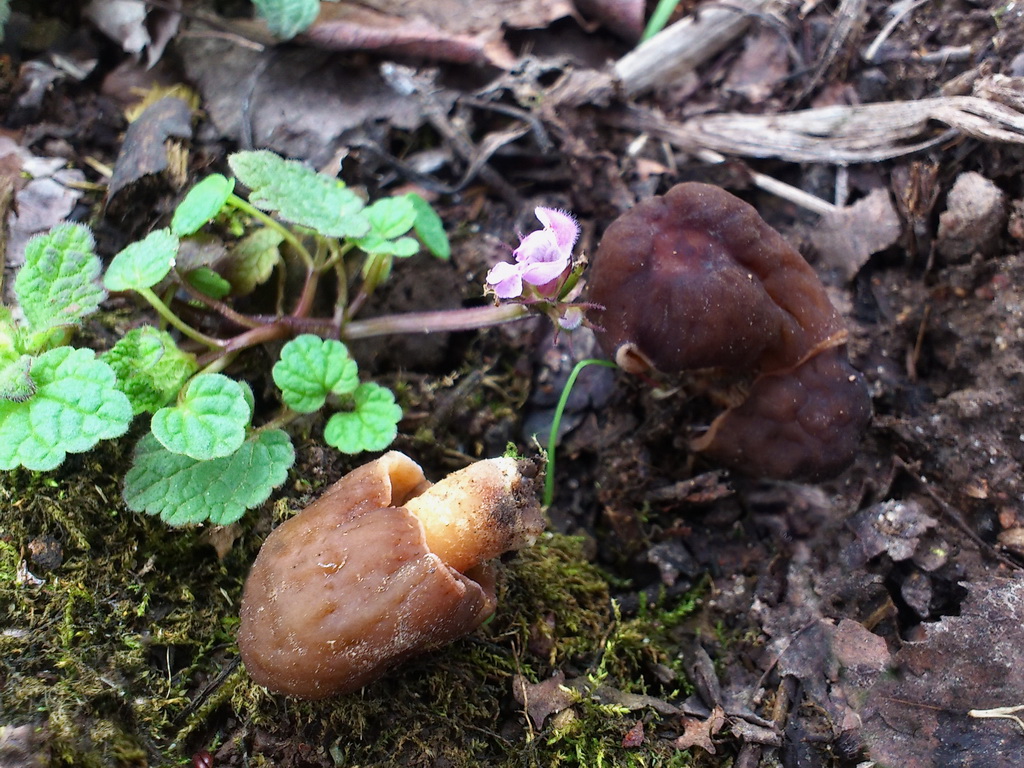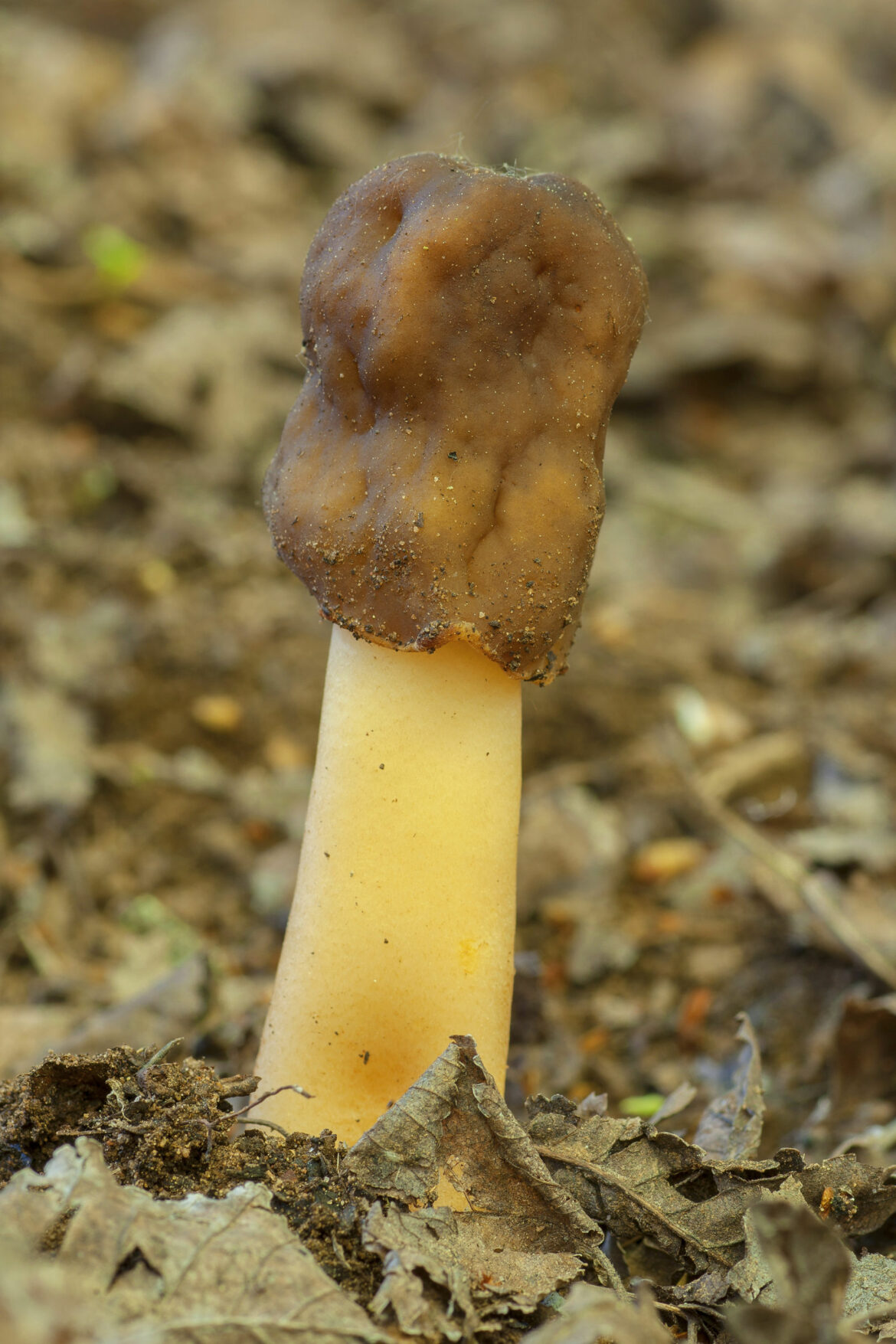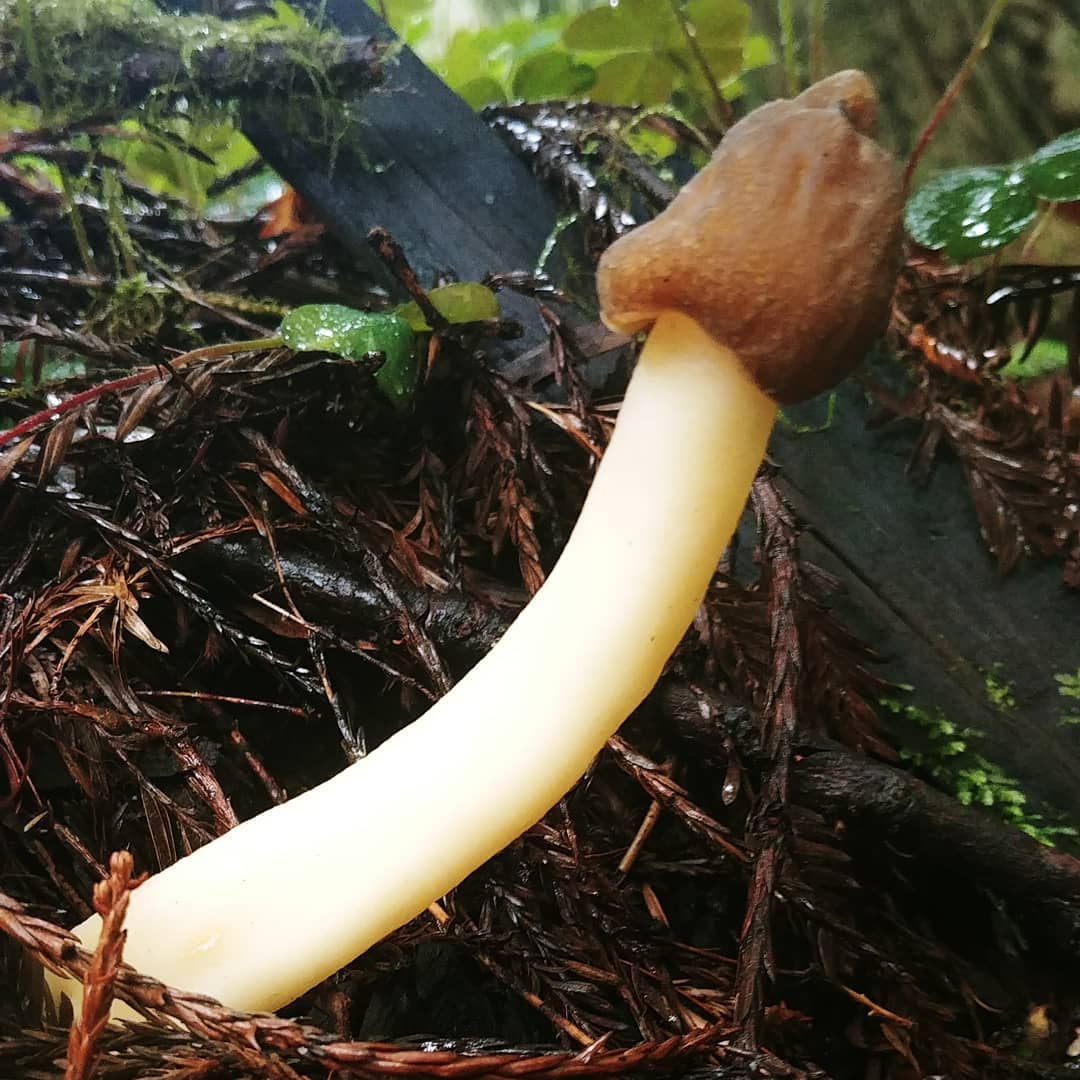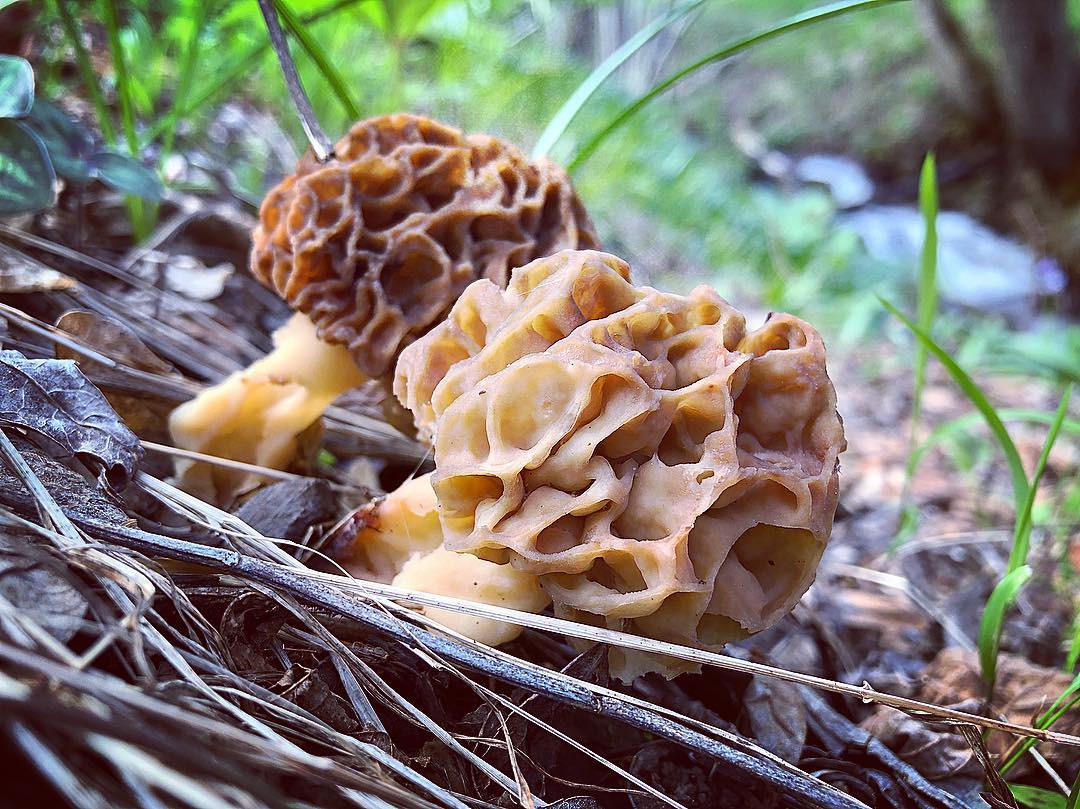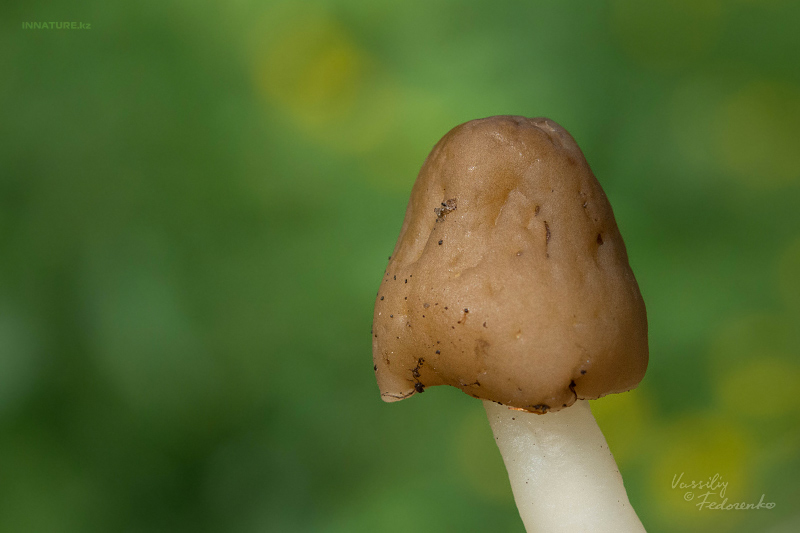Difference from false doubles
The morel cap has a characteristic appearance that is difficult to confuse with other types of morels. A feature that helps to calculate it almost accurately (including from photographs) is a loosely attached hat that easily tilts from side to side or comes off.
Stitching and morel cap
However, sometimes inattentive and inexperienced lovers of quiet hunting confuse a mushroom with lines. There are different opinions about the edibility of the latter, since even after processing, a certain amount of poison remains in their fruit bodies. If your health is dear to you, it is advisable to refrain from using lines in any form.
Morel cap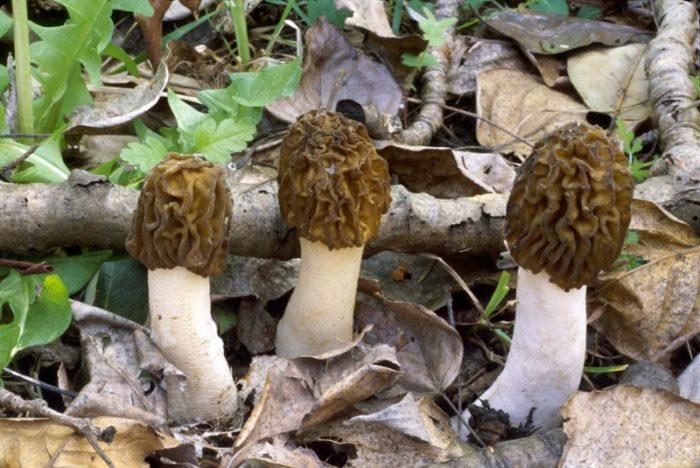 |
Stitching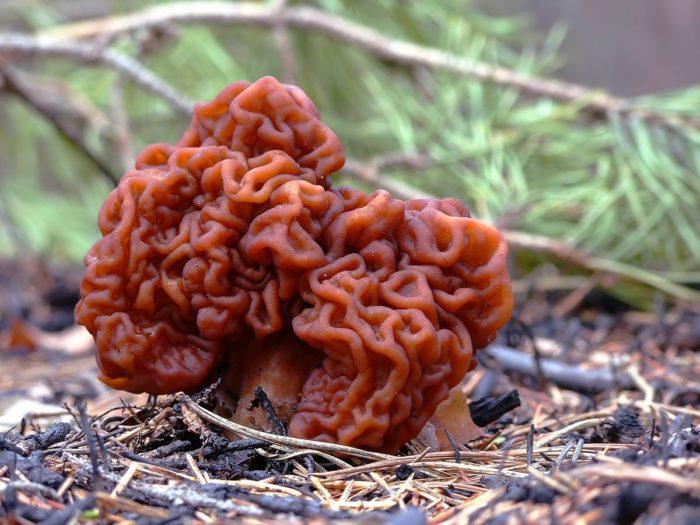 |
| the cap is freely attached to the leg | the edges of the cap are firmly attached to the leg |
| slender leg with a flat surface | leg of irregular shape |
| grows in deciduous forests | grows mainly in coniferous forests |
| soft, pliable pulp | tough and firm flesh |
Stitching
A few words about the lines (Gyromitra). From time immemorial in Russia, they ate lines with preliminary boiling and draining of water. And our family as well. But the Europeans manage to poison themselves with them, and a fatal outcome has also been recorded. Mycologists associate poisoning with gyrometrins toxins, which accumulate in the lines in different ways: somewhere more, somewhere less.
If you have no experience of using lines, it is better not to risk it. If there is any doubt about the definition of the mushroom, it is better to leave it in the forest - the forest dwellers will figure it out. And the most important thing is not to be greedy: you do not need to eat a frying pan of fried mushrooms at a time. You can try a little and postpone the rest until tomorrow. A pan with mushrooms will not run away. Checked!
Structural features and description
Morel cap (Latin names - Verpa bohemica, Morchella bohemica) belongs to the genus Verpa (Verpa) and the Morel family (Morchellaceae). The species is not listed in the Red Book.
The mushroom was named due to its obvious resemblance to the true morels, to which it does not belong, and the cap, which is easily detachable from the stem and resembles an old cap in its shape. In different places of the planet, the Morel Cap has several alternative names:
- Verpa Czech;
- Cap;
- Morel tender;
- The morel cap is conical.
The small cap is covered with vertical folds with a wrinkled surface, in appearance it resembles a walnut. Its diameter reaches 2–4 cm, height - 2–5 cm. In youth, it is colored chocolate brown, in the process of ripening it becomes yellow. The color is influenced not only by the age of the fruiting body, but also by the area in which the mushroom grew.
The pulp is colored to match the color of the leg, easily breaks and crumbles, has a light pleasant aroma and mild taste. In youth it has a cotton-like structure, then it becomes similar to wax.
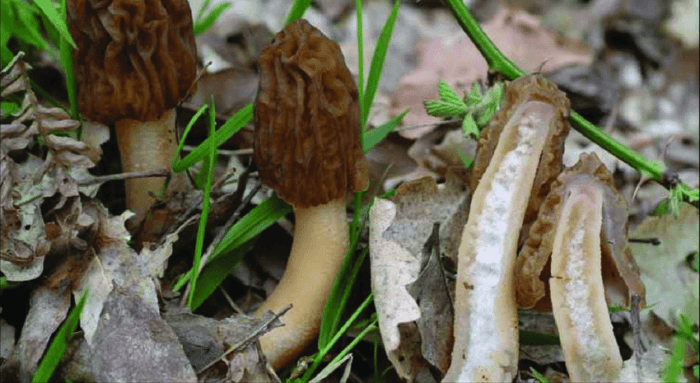
The lower part of the cap (hymenophore) is colored in lighter shades and has a surface that is more delicate to the touch than the cap. Covered with small yellow spores with an elongated oval shape.
The leg is often curved and flattened from the sides, it grows up to 2 cm in thickness and up to 7–10 cm in height. It has a very fragile connection with the cap. In the process of growth and thickening of the leg, a void channel filled with air appears and expands in it. The surface is smooth, painted in white or cream color, covered with medium-sized scales or grains. Covered with a thin layer of fluffy plaque, easily erased with an ordinary touch of a finger.
A bit of history
The first scientific description of the morel cap was given by the German mycologist Julius Vincenz von Krombholz in 1828. It received its modern place in the taxonomic classification in 1893 thanks to another German, Joseph Schroeter.
Morel Cap - Verpa bohemica
Written by Nikolay Budnik and Elena Meck.
Morel caps are one of the first spring mushrooms. Their collection is the first trips to the forest after a long winter. And the air is intoxicating, and the birds are singing, and the sun is shining - good!
Our harvest of Morel hats is not big every year. For example, in 2012 it was possible to collect a whole two-bucket basket.
And in 2013 there were very few of these mushrooms; we only found a few.
Morel caps are delicious mushrooms. They can be fried immediately, without boiling. You can dry them. But for some reason no one collects them on Ulom Zheleznaya.
1. Morel cap on Ulom Zheleznaya begins to grow in early May.
2. Growth usually continues until the twentieth of May.
3. Mushrooms begin their growth when there is practically no grass yet.
4. Next to the morel cap, bright cups of sarcoscifs are visible.
5. The grass is getting taller.
6.. and among it there are slender beautiful mushrooms.
8. The mushroom cap resembles the human brain.
10. Sometimes a mushroom grows over a blade of grass.
11. Morel cap is juicy and even watery at first.
12. Gradually the hat becomes drier and the leg gets longer.
13. And this mushroom did not grow up, but sideways.
15. It's nice to find the first morel caps.
16. They appear in places heated by the sun.
17.. in a deciduous forest.
eighteen . among birches, aspens, alder, willow.
19. First, you need to look for hats on the edges.
20. ... and then inside the forest.
23. Morel cap is quite a worthy mushroom in size.
24. It may be less.
26. or very large.
27. At first, only the hat is shown from the ground.
28. the leg is almost invisible.
29. The hat is very light, almost gray.
32. or dark brown.
33. The hat dries up with age.
35. The morel cap is called that way because the cap is removed from the leg like a cap.
37. The leg is almost white and fragile.
38. Inside, it is hollow or wadded in places.
40. Gradually it becomes longer and longer.
40a. The leg is pulled up more and more.
44. These morel caps were found on May 5th.
45. They are light and short-legged, with large caps.
48.. and in section.
49. The flesh of morel caps is fragile and brittle.
51.. and this is a cut of the mature.
52. We think that there are different races of the morel cap. These ones are light and short-legged.
54. Once again let us admire the mushroom in nature.
56. Morel hats, collected on May 17, 2012.
57. This is how they are - wonderful spring morel mushrooms.
A small video about collecting Morel caps
There is one more film about where it is better to look for the Morel Cap.
Romantic sarcoscife
Now my dog and I are walking through the forest in the foothills of the Caucasus, in the vicinity of Goryachiy Klyuch. There is a forest behind our house, therefore part of the plot has both garden and undergrowth vegetation. It was there, at the end of February, not far from the flowering cyclamenchiks, remarkably bright red "cups" began to appear. Among the first green leaves in the fallen leaves, they look very touching.
Scarlet sarcoscine (Sarcoscypha coccinea), or Scarlet elf bowl (what a suitable poetic name for a mushroom the size of a two-ruble coin!). An edible mushroom that grows exclusively in ecologically clean places (balm for the soul of the owner of the site). Very similar to the Austrian elf cup, but it grows to the north.
One or the other, or even both at once, are found in early spring almost throughout the country. The difference between the species is seen, as a rule, by specialists; simple mushroom pickers do not pay attention to the shape of the hairs of the outer surface. Moreover, you can only see them under a magnifying glass.
In fact, these mushrooms grow up to 7 cm, but I have not come across such. And although they are edible, they have a rubbery-cartilaginous structure and no special taste. Stew in sour cream or bake with cheese.
But this mushroom has remarkable decorative qualities. In Europe, in early spring, they make small gift baskets with green moss and sarkoscifs. A good alternative to flowers that are no longer in short supply. It is impossible to confuse sarcoscifa with other mushrooms.
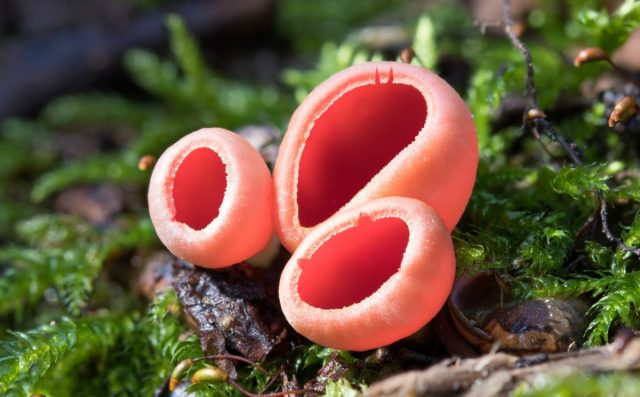 Sarkoscif scarlet, or Scarlet elf bowl (Sarcoscypha coccinea). Claude-Alain Berdoz
Sarkoscif scarlet, or Scarlet elf bowl (Sarcoscypha coccinea). Claude-Alain Berdoz
Such different morels
And here is an old friend - morel (Morchella)! That is, as if an old acquaintance, but changed. Here, in the Kuban, I often come across at first morel caps and a little later - conical morels, but in the suburbs, I remember, there were mostly real ones.
In general, morels and morel-like mushrooms are of several types.
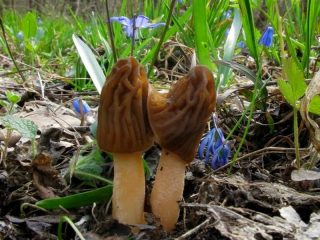 Morel cap (Verpa bohemica). blabto
Morel cap (Verpa bohemica). blabto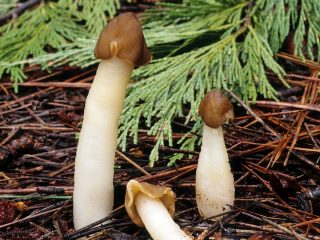 Conical cap (Verpa conica). Fred stevens
Conical cap (Verpa conica). Fred stevens
Morel cap and conical cap
I would call a morel cap (Verpa bohemica) a morel bell - its cap is conical, it grows to the stem at the very top, it seems that it even dangles. Otherwise, it looks like a morel.
The conical cap (Verpa conica) may have a smooth cap. The mushroom itself is rather miniature, like a finger with a thimble on. The legs of the mushrooms are hollow, although the morels at a young age have loose flesh inside. You can confuse hats with morels when viewed from above. Beanies prefer wet places. Mushrooms are quite edible, not the lowest category, but not the highest either.
Steppe Morel (Morchella steppicola). Viktor Sevidov Edible cone (Morchella esculenta). Andreas Kunze Semi-free mucus (Morchella semilibera). H. Krisp
Morels
With morels, things are not so simple. Behind the morels has long and thoroughly been trailing a trail of information about "conditional edibility", although these are delicious edible mushrooms that are not noticed by mycologists in any unhealthy manifestations, and in Europe and America, in general, these mushrooms are considered a delicacy.
Another thing is that inexperienced mushroom pickers often confuse it with a poisonous line, collecting both together - here, of course, you need to carefully study each mushroom and throw out everything suspicious.
The steppe morel (Morchella steppicola) is radically different from all others - a stocky mushroom on a short or very short stem, sometimes reaching a size of 25 cm and a weight of 2 kg. And his hat is wrinkled, grayish-brown. Grows in wormwood steppes or forest-steppe. Listed in the Red Book of Kalmykia, Rostov, Saratov and Volgograd regions.
The most common in Russia is the edible morel (Morchella esculenta) - a mushroom on a long stem with an ovoid or rounded cap, firmly adhered to the stem. If cut, it is hollow inside, one skin. Therefore, mushrooms are quite light. You can fill a basket, but it is easy to carry. When you start frying, you immediately feel that 30% of the forest air has been brought home.
An even void inside the morel is a significant difference from a line containing poisonous compounds. The line has a sinuous pulp inside, rather chaotically intertwined. Morel is somehow more harmonious, in my opinion.
Cutting morels is a mandatory operation not only to identify the fungus, but also to drive slugs out of the warm edible place. Or other living creatures that use the morel cavity for their, not always harmless, purposes.
The lines are most often hidden in the litter, and a curly hat sticks out of them, while the morel's leg rises above the litter and the mushroom is visible in its entirety.
It is quite easy to identify the semi-free morel (Morchella semilibera): its cap grows to the stem at half the height, and the bottom is free. It also doesn't smell very good. But it is quite edible, however, it is not often found.
There is also a thick-legged morel (Morchella crassipes) with thick, long and somewhat corrugated legs, a rare mushroom.
The conical morel (Morchella conica), the cap of which may not even be conical at all, but rounded, is similar to the gourmet morel (Morchella deliciosa), but it is more common.
Morels grow almost everywhere. In the forest, where there is a lot of last year's dry grass, you need to get used to looking for them, you cannot immediately see them. But on burned-out areas, not old clearings, in pine forests they can be seen well and they grow there willingly.
Since ancient times in Russia, morel tincture was used for eye diseases: myopia, farsightedness, clouding of the lens and cataracts. Morel preparations also have antitumor, immunomodulatory, antiviral and anti-inflammatory activity.
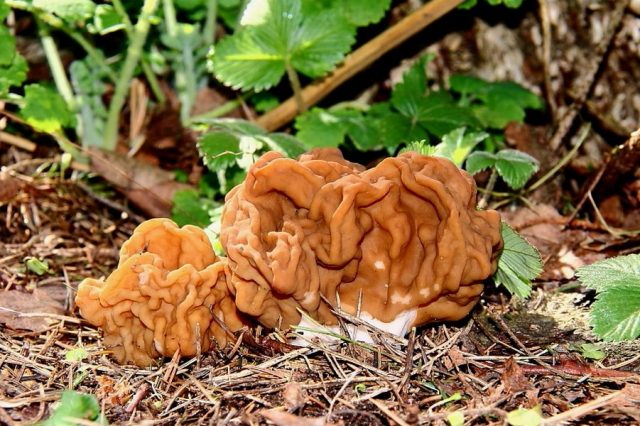 The line is giant (Gyromitra gigas). Imbi vahuri
The line is giant (Gyromitra gigas). Imbi vahuri
Strange sarcosoma
Mushrooms in the form of bowls (sarcoscif, petsitsa) are often found in spring, but the mushroom in the form of a closed pot was only seen once. Sarcosoma globosum (Sarcosoma globosum) does not particularly refer to edible, to a much greater extent - to medicinal. Although there is information that young mushrooms are delicious stewed with potatoes, and the dish is called sarkosomnik. This, apparently, in those places where there is a lot of it.
The fungus is a container with a transparent gelatinous liquid, covered with a leathery disc on top, on which spores develop. The fruiting body, together with its contents, can weigh 300 grams. People call the sarcosome liquid "earth oil" and use it in a variety of ways:
- for rejuvenation - rubbed into the skin;
- to enhance mental activity - take fresh liquid on an empty stomach;
- to enhance hair growth - rub into the scalp;
- for diseases of the joints - rubbed into the sore spot;
- as a biostimulant - also fresh liquid on an empty stomach.
Sarcosoma also has a tonic, calming effect, and is used in the fight against cancer. It's a pity that I only got one mushroom!
For growth, sarcosoma prefers a coniferous forest and deftly hides in moss and coniferous litter, it is not so easy to find it. Young mushrooms are smooth brown balls with caps. With age, mushrooms become more and more wrinkled until they dry completely, turning into a crumpled plate.
It is problematic to confuse sarcosoma with other mushrooms: the liquid and the top cap are the most striking distinguishing features.
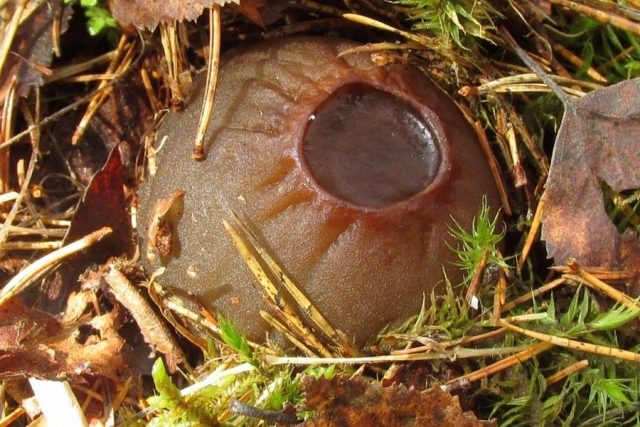 Spherical sarcosoma (Sarcosoma globosum). Sergey TashebskySergey Tashebsky
Spherical sarcosoma (Sarcosoma globosum). Sergey TashebskySergey Tashebsky
TREMELLA MESENTERICA
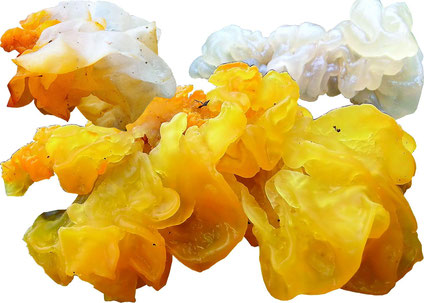
System:
NormalfalsefalsefalseRUJAX-NONE
Kingdom: Mushrooms (Fungi)
Department: Basidiomycota
Class: Tremellomycetes
Order: Tremellales
Family: Tremellaceae
Genus: Tremella
Species: Tremella mesenterica (Batsch) Šutara (1992)
Fruit body: pale yellow, yellow, sometimes to orange, partly transparent, 1-10 cm, at a young age cerebral, later folded, gelatinous, dense gelatinous, often with a sticky surface. In dry weather, the fruiting bodies dry out, taking the form of crusts adhering to the substrate. When the humidity changes, the crusts swell and the mushroom regains its normal shape. With excessive moisture, it fades to white, translucent. Old fruit bodies dry out, darken, become flattened and coarser. Habitat: like the fucus-shaped shiver, this fungus parasitizes on the mycelium of the host fungus (tinder fungus of the genus Peniophora) located in rotting wood. Following the host fungus, it settles on the trunks, branches and stumps of deciduous, much less often conifers. Sometimes there is a simultaneous fruiting of the tremor and the peniophora affected by it.
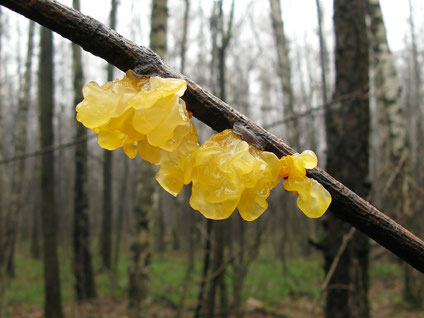
Fruiting period: from August to May (freezes in winter and continues to develop in a thaw). Distribution in the Russian Federation: throughout the forest zone, often abundantly in places.
Similar species: Fruit bodies, discolored to white in rainy weather, can be confused with trembling fucus. But only in the Primorsky Territory.
Edible: the mushroom is edible, used fresh for salads (with the addition of sweet and sour dressing). From fresh or dried fruit bodies, nutritious broths are cooked.
In China, it is considered a delicacy; among other recipes, it is used to prepare immunomodulatory cold vegetarian soups (with the addition of lotus seeds, lily bulbs, Chinese dates, etc.).
Medicinal properties: the biologically active polysaccharide glucuronoxylomannan was isolated from the orange shiver. Laboratory tests have shown that it has immunostimulating, radioprotective, antidiabetic, anti-inflammatory and anti-allergenic activity, and also participates in the protection of the liver (hepatitis B).
Ethanol extract of fresh fruit bodies causes complete death of A549 cancer cells (lung cancer), increases the production of interferon and interleukin-2, kills cervical cancer cells and enhances the effect of chemotherapy.
In China, on the basis of glucuronoxylomannan, several medications are patented (antineoplastic, anti-inflammatory, blood pressure regulating).
The fruit bodies of the tremors contain essential amino acids and B vitamins, which makes these mushrooms valuable not only in medicinal but also nutritionally.
For medicinal products, the mushroom is cultivated by the deep method (China).
In Chinese folk medicine, the orange tremor was used as a general tonic, for the treatment of pulmonary diseases, bronchitis, as well as for paralysis, eye inflammation, and as a sedative.Known use in England (rubbing with a fresh fruiting body) for the healing of skin ulcers.
Cookie Policy Mikhail Vishnevsky, 2012-2019 Log out | EditLAT Tremella mesenterica Edible Synonyms: Filmy Tremella, Dragla, Helvella mesenterica, Hormomyces aurantiacus, Tremella brasiliensis, Tremella lutescens, Tremella lutescens var. brasiliensis
Specifications:
| Group: | Indefinite |
|---|---|
| Plates: | Absent |
| Colour: | White to orange |
| Info: | Jelly-like fruiting body |
Systematics:
| Department: | Basidiomycota (Basidiomycetes) |
|---|---|
| Subdivision: | Agaricomycotina (Agaricomycetes) |
| Class: | Tremellomycetes (Tremellomycetes) |
| Subclass: | Tremellomycetidae (Tremellomycetids) |
| Order: | Tremellales |
| Family: | Tremellaceae (trembling) |
| Genus: | Tremella |
| View: | Tremella mesenterica (Orange trembling) |
The mushroom is edible, but practically never used in Russia. This is due to the difficulty of transporting this mushroom from the place of collection (it dissolves quickly).
Conical cap
Appearance (description)
Morel cap is a large and fleshy mushroom with a height of about 15 cm. A characteristic feature is that the edges of the cap are free. They do not grow with the lower edge to the stem, so it is easy to identify this type of mushroom by its appearance. If you look at the mushroom, it resembles a finger with a thimble on it.
The fruit body grows up to 15 cm tall.
The cap does not grow together with the leg and is attached to it like ordinary mushrooms. The height of the cap is 2-5 cm, the width is 2-3 cm. The shape is bell-shaped, folded. Color - brown or yellow-brown, depends on the area where morel caps grow and their age. The older the fruiting body, the lighter the color. In young individuals, the cap is pressed against the leg, although it fuses with it, and in old individuals, the cap is bent to the side. Outside, the cap is covered with longitudinal folds that resemble a walnut or cerebral convolutions. The lower part is light in color, smooth, delicate and velvety.
The leg is very fragile, cylindrical, narrowed at the sides, 6-10 cm high, 1.5-3 cm thick. They are never even. Young morel caps have a white or light cream-colored leg. The older the mushroom, the darker the stem becomes. With age, it becomes hollow. A slight bloom may be present, which, like a fluff, covers the entire leg. If you touch this gun, then it is easily erased.
Spore powder elongated, smooth, elliptical, yellowish-buffy.
The pulp of a young leg resembles cotton wool. The flesh of the cap breaks very easily. It is waxy and thin.
Smell and taste. Morel hats smell of dampness, although this smell is inexpressive and very light. The taste of ready-made mushrooms is not very pronounced, therefore the mushroom is considered low in quality.
Edibility
If the mushrooms are too contaminated, then they must be soaked in cold salt water before boiling to remove excess dust, sand and insects that could hide in the winding cap.
The morel cap, despite its tenderness and fragility, can be dried, but they should be dried for at least 30 days, and it is better to cook them after 3 months without prior boiling.
It is better not to pick large mushrooms of this type, as they accumulate a large amount of toxic substances that may not collapse during boiling.
Similarities with other species
It is very difficult to confuse the morel cap with other types of mushrooms, since this type of mushroom can be called unique. It differs from other types of morels in that the edges of the cap do not grow together with the leg. As soon as this external sign is established, there is no doubt that this is a Czech verpa or a tender morel.
The main thing is not to confuse these mushrooms with lines, which are poisonous mushrooms.
Red Book
Are you here:
Home - The Red Book of the Leningrad Region. Plants - Morel cap conical
Morel cap, conical
Verpa conica (O. F. Miill .: Fr.) S> v. (Ascomycota, Morchellaccac) Status. 3 (R). A rare species
Short description. A mushroom with medium-sized and waxy fruiting bodies that develop on the soil.Hat 1.5-3 cm high, 1.5-2.5 cm in diameter, bell-shaped, blunt-conical, thimble-shaped to cylindrical, adherent to the stem only in the middle, smooth or slightly wrinkled, honey-buffy to reddish-brown, sometimes olive-tinted, ocher underside. Stem 3-13 x 1-1.5 cm, cylindrical, slightly uneven, at first cotton-like inside, soon hollow, whitish, buffy, with a darker granular bloom forming poorly expressed zones. The pulp is waxy, brittle. Spore powder, cream. Spores 20-25 x 12-15 microns. wide-ellipsoidal. 8-spore bags.
Spreading. Found in env. lake Langozero on the Vepsovskaya Upland (Tikhvinsky District) (I) and on the territory of St. Petersburg in the env. Levashovo and Shuvalov (2). In Russia, it was also noted in the Polar Urals (3). Outside Russia, it is distributed in Europe, North Africa and North America (4-6).
Ecology and biology. Humus saprotroph. Found in moist deciduous forests in May June.
Limiting factors. Drainage and deforestation, high demands on the richness of the soil.
Security measures. Protected in the natural park "Vepsian Forest". Search for new locations is required.
Sources of information: I. Author's data: 2. Naumov. 1964; 3. Karatygin et al. 1999: 4. Breitcnbach, Kranlin, 1984: 5. Phillips. 1981; 6. l.incolf. 1997. A. E. Kovalenko
Status. 3 (R). Rare.
Description. Fungus with waxy, medium-sized fruit bodies developing on soil. Cap 1,5-3 cm high. 1,52,5 cm in diam .. campanulate, truncate conical, thimbleshaped, cylindrical, adnatc to stipe by central part only, smooth or slightly wrinkled, honey ochraceous to reddish brown, sometimes with olivaceous tinge, lower surface ochraceous. Stipe 3 13 x 1-1.5 cm, cylindrical, slightly uneven, at first cotton-wooly within, soon hollow, whitish, ochraceous. with darker granular coating which forms weakly expressed zones. Flesh waxy, fragile. Spore print cream. Spores 20-25 x x 12-15 pm, broadly ellipsoid. Asci 8-spored.
Distribution. In the Leningrad region in the vicinity of Lake Langozeroon the Veps Hills (Tikhvin district) (1) and in St. Petersburg in the vicinities of Levashovo and Shuvalovo (2). In Russia also recorded from the Polar Urals (3). Outside Russia occurs in Europe. Northern Africa and North America (4-6).
Ecology and biology. HumiS> colous saprotroph. In the Leningrad region found in moist deciduous forests in May - June.
Limiting factors. Drainage and forest felling, strongly demands rich soil.
Conservation measures. Protected in the Vepssky Forest nature park. A search for new localities required.
Sources of information: I. Au- 3 tlior's data: 2. Naumov. 1964; 3. Ka-LL ratygn et al. 1999: 4 Breitenbach. Kriinzlin. 1984; 5. Phillips. 1981: 6. Lincoff. 1997. .1. E. Kovalenko
|
16.11.2018 19:42:00
-
Menu
- home
- Photo gallery
-
Animals
- Mammals
- Birds
- Fishes
- Amphibians
- Reptiles
- Insects
- Crustaceans
- Worms
- Molluscs
-
Plants
- Angiosperms
- Gymnosperms
- Ferns
- Mosses
- Seaweed
- Lichens
- Mushrooms
- Moscow
-
Moscow region
- Mammals
- Birds
- Invertebrates
- Pisces, presm., Terrestrial.
- Plants
- Mushrooms, mosses, lichens
-
Voronezh region
- Plants
- Animals
-
Republic of Crimea
- Plants
- Animals
-
Rostov region
- Plants
- Animals
-
Krasnodar Territory
- Plants
- Animals
-
Leningrad region
- Plants
- Animals
-
Pskov region
- Plants
- Animals
-
Sverdlovsk region
- Plants
- Animals
-
Saratov region
- Mushrooms
- Bryophytes
- Ferns
- Amur region
- Krasnoyarsk Territory
- Belgorod region
-
Chelyabinsk region
- Plants
- Animals
-
IUCN Red List
- Extinct mammals
- Rare birds of the world
- Cetaceans
- Carnivores
- Reserves of Russia
- Wild animals
- Birds of Russia
- Download the Red Book
- Basic documents
- Custom sog.
- .

